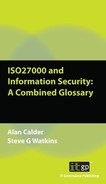U
UKAS – United Kingdom Accreditation Service: the sole national accreditation body recognised by the UK government to assess, against internationally agreed standards, organisations that provide certification, testing, inspection and calibration services. See website at: www.ukas.com.
Untrusted – (or not trusted) a device (usually) that is not, or cannot be assumed to be, securely configured and not subject to malicious action.
Update – ‘a broadly released fix for a specific problem addressing a non-critical, non-security-related bug’ – Microsoft.
Update services – see Automatic updates.
Upgrade – a newer version of an already installed software package; the upgrade process should leave existing data and user preferences intact while replacing the existing software with a newer version.
UPS – an Uninterruptible Power Supply is a device which is designed to keep other electrically powered devices operating when the normal power supply fails. A UPS should, at the very least, be rated as capable of meeting the power requirements of the device(s) it is supporting for long enough to allow an orderly shutdown of the services. The length of time required for this may need to be ascertained by testing.
URL – the Uniform Resource Locator is the address of a website on the World Wide Web.
USB – the Universal Serial Bus is a computer standard designed to eliminate the guesswork in connecting peripherals to computers.
USB stick (or flash card) – is a portable memory device with a USB.
Usenet – Internet-based public bulletin board that allows users to post messages to different news groups.
User – an individual, or an automated process or system that has access rights to a specified system.
User account – a set of rules defining an individual’s access to files and systems on a computer.
User agreement – this is the formal, standard document that all new users should be required to sign before they are issued with their user name. This agreement should describe their access rights and should set out the organisation’s requirements around system use, password choice and protection.
User ID – see User name.
User name – every user should have a specific and unique name for use on the system. This name should be created and allocated in line with a standard procedure and should be set up on the system with specific access rights and privileges. The user name has to be created before the user can access the system for the first time.
User rights – the specific application access rights associated with a specific user name.
